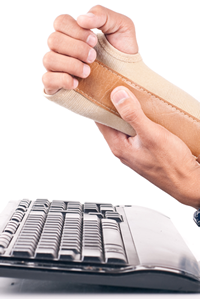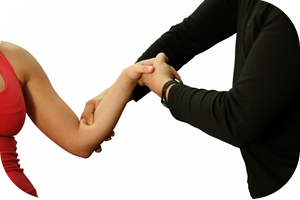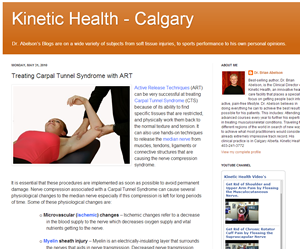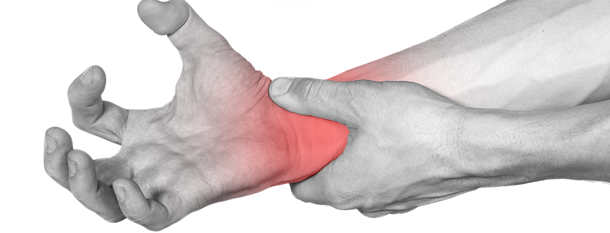Resolving Carpal Tunnel Syndrome
 Traditional medical treatment and surgical interventions for Carpal Tunnel Syndrome have been resoundingly unsuccessful. This failure is largely due to the overemphasis on the role of the actual carpal tunnel with regards to peripheral nerve entrapments.
Traditional medical treatment and surgical interventions for Carpal Tunnel Syndrome have been resoundingly unsuccessful. This failure is largely due to the overemphasis on the role of the actual carpal tunnel with regards to peripheral nerve entrapments.
But there is a working solution that you can use, to find real relief from Carpal Tunnel Syndrome as well as other Nerve Entrapment Syndromes! Click on each of the tabs in the following section for more information about:
- What Causes CTS?
- Finding the Entrapment
- Why Release Nerves?
- Treating CTS
- Expected Results
- Conclusion
What Causes Carpal Tunnel Syndrome?
 CTS can be caused by any repetitive motion that stresses the upper extremities of the body (hands, arms, shoulders, neck, and head).
CTS can be caused by any repetitive motion that stresses the upper extremities of the body (hands, arms, shoulders, neck, and head).
The increased use of computers and their accompanying flat, light-touch keyboards that allow for high-speed typing, has resulted in an epidemic of injuries to the hands, arms, shoulders, and neck. In addition, the increased usage of pointing devices such as the computer mouse and trackball (which require repeated subtle movements) add to these injuries. And now, we can add the light, portable tablets and smartphones, which require propping up in awkward positions, and light finger movements to the culprits of CTS.
The thousands of repeated keystrokes and long periods of clutching and dragging with the mouse cause chronic irritation to soft tissue (nerves, muscles, ligaments, fascia, and tendons). This irritation creates friction and pressure, which eventually leads to small tears within the soft tissue. These in turn cause inflammation, decreased circulation, and swelling (edema).
CTS injuries are aggravated by:
- Poor posture and body positions.
- Lack of core stability.
- Poor ergonomics (positioning of the chair, mouse, monitor, keyboard, assembly line, and so on).
- Decreased strength due to poor conditioning or injury.
- Insufficient relaxation and rest time away from the stresses that cause the problem.
- Excessive force that is required to perform an action.
- Muscle imbalances.
Finding the Exact Area of Nerve Entrapment
If you truly want to resolve your CTS, it is very important to first locate all the sites of your median nerve entrapment. In addition, it is not uncommon for patients to come into our clinic with a general diagnosis of CTS (median nerve entrapment), but upon examination, show symptoms of either radial or ulnar nerve entrapment (known as Pseudo-CTS).
Diagnosing the Cause of your CTS
To do this, your practitioner must obtain a complete patient history, perform an orthopedic and neurological examination, and then follow-up with an extensive palpatory examination to find indications of the exact entrapment sites.
This hands-on palpatory examination of all the possible entrapment sites is one of the most important steps in the evaluation process. The tactile sensitivity of the practitioner’s hands is used to identify changes in tissue texture, tissue tension, and abnormal tissue movements. This is often the key step required for discovering all the entrapment sites that need to be released.
A biomechanical evaluation is also necessary. Deviations from normal motion patterns are direct indicators of the structures involved in a specific injury. This information helps the practitioner determine whether the primary muscles (agonists) that perform the action or their oppositional muscles (antagonists) are involved.
These tests, combined with an examination of kinetic chain functions, as well as standard orthopedic and neurological tests, provides the ART practitioner with the information required to identify and resolve your CTS.
Inappropriate diagnoses often occurs when physicians do not pay attention to the actual symptom patterns or when they have not performed a complete examination. Median, radial, and ulnar nerve entrapment patterns have very different symptoms, and need to be treated with different ART protocols.
For more information about this process, see:
- Treating CTS with Active Release Techniques.
- Release Your Pain – Resolving Soft Tissue Injuries with Active Release Techniques. We have a full chapter dedicated to this condition, along with special exercises to help you begin the healing and recovery process.
- Exercises for the Shoulder to Hand – Release Your Kinetic Chain. Ready to progress further? This book gives you customized routines that progress from initial rehabilitation into performance care for each of the key kinetic chain structures that are impacted by CTS and other nerve entrapment syndromes.
Why Release the Nerves?
Entrapment of the median, radial, and ulnar nerves in the arm can all present with similar symptoms. By properly identifying which nerve is affected, your ART practitioner can then begin treating the appropriate kinetic chain structures.
It is essential to release these structures as soon as possible in order to avoid permanent damage to the nerves. Nerve compression caused by CTS can cause several physiological changes to the median nerve, especially if this compression is left untreated for long periods of time.
Some of these physiological changes include1:
- Microvascular (Ischemic) Changes – Ischemic changes cause a decrease in blood supply to the nerve, which in turn results in decreased delivery of oxygen and vital nutrients to the nerve.
- Myelin Sheath Injury – Myelin, the electrically insulating layer that surrounds nerves, aids in signal transmission. A decrease in signal transmission results in decreased function.
- Demyelination – This is the actual loss of the myelin covering on nerve fibres. Chronic cases of nerve compression can cause Wallerian Degeneration. Wallerian Degeneration describes the degeneration of the nerve and is often accompanied by permanent fibrotic changes that prevent the re-innervation and restoration of nerve function. Re-innervation is the process that occurs when a nerve dies and a nearby nerve grows a new axon that connects into the affected muscle and takes over the function of the dead nerve.
- Muscle atrophy is one of the most common side-effects of nerve impingement. Objective changes may not be seen until these atrophied muscles have regained strength. This is why we emphasize the use of special, customized exercise routines with every ART treatment. See Exercises for the Shoulder to Hand for specific exercise routines that are designed to restore neuro-muscular communication and function of structures affected by CTS.
Treating CTS with Active Release Techniques (ART)
ART can be a very successful technique for treating Carpal Tunnel Syndrome (CTS) due to ART’s ability to both find the specific tissues that are restricted, and then physically work them back to their normal texture and tension. ART’s hands-on methodology releases the median nerve from its abnormal attachments to the muscles, tendons, ligaments, or connective structures that are causing the nerve compression syndrome.
Dr. Abelson palpating and treating the structures along the median nerve.
Releasing the Entrapments
Once the actual areas of restriction have been located, ART procedures can be used to release the areas of nerve entrapment. During the ART treatment, the practitioner will take the affected area from a shortened to a lengthened position while having the patient move the arm in the appropriate direction.
Depending on the location of the entrapments, the practitioner may use different combinations of ART protocols to release the restrictions; thus, your treatment may vary considerably from that experienced by another patient with CTS. ART treatments for CTS should address all possible nerve and vascular entrapment sites including, but not limited to the:
- Median nerve at the carpal tunnel and at the pronator teres.
- Radial nerve at the wrist extensors.
- Ulnar nerve at the medial edge of the triceps, at the wrist flexors, and at the subscapularis.
- Brachial plexus at the scalenes.
 It should be noted that ART treatments for Pseudo-CTS should not be restricted to just these sites, but may often include other locations in the arm, shoulder, neck, and back. The actual order and type of ART protocols that are applied varies depending upon each individual, and the exact location of the restricted tissues.
It should be noted that ART treatments for Pseudo-CTS should not be restricted to just these sites, but may often include other locations in the arm, shoulder, neck, and back. The actual order and type of ART protocols that are applied varies depending upon each individual, and the exact location of the restricted tissues.
It is essential to find an ART practitioner who has taken the ART Upper Extremity Course, and has maintained all ART certifications. Practitioners who have also received certification in ART’s Long Tract – Nerve Entrapment Courses would be able to help you even more.
What Results Can You Expect from an Active Release Treatment?
 You can expect fairly high rates of resolution for CTS if you are in the hands of an experienced ART practitioner. These practitioners follow a specific process when performing CTS treatments.
You can expect fairly high rates of resolution for CTS if you are in the hands of an experienced ART practitioner. These practitioners follow a specific process when performing CTS treatments.
- They first look for, and feel for changes in tissue tension, tissue texture, tissue movement, and tissue function.
- After each treatment, the practitioner often feels immediate changes in each of the above components.
- After each treatment, the patient will often see immediate changes in strength, speed-of-motion, endurance, and function.
- After a few treatments, the practitioner will look for some type of functional improvement. In most cases, you can expect to see a decrease in symptoms (decreased pain) and an increase in function (ability to perform tasks).
It is very important for you, the patient, to communicate with the practitioner about changes in your CTS. Has your condition improved? Stayed the same? Gotten worse?
Of course, the degree and speed of change is dependant upon the severity of your restrictions, and the length of time you have been suffering from CTS. If there is no improvement, the ART practitioner will address two of the most probable reasons for the lack of change:
 There may be multiple entrapment sites that need to be released: If you find that the initial treatments are not entirely effective, then your episode of CTS could involve multiple entrapment sites. The primary source of the problem is sometimes not obvious until a few treatments have been completed. So be patient, and be sure to communicate with your practitioner.
There may be multiple entrapment sites that need to be released: If you find that the initial treatments are not entirely effective, then your episode of CTS could involve multiple entrapment sites. The primary source of the problem is sometimes not obvious until a few treatments have been completed. So be patient, and be sure to communicate with your practitioner.
Strength must be developed: Sometimes, even after all the restrictions have been released, the patient will see only minor measurable improvements. This can be caused by a lack of strength in the affected soft-tissue structures.
Muscle atrophy is one of the most common side-effects of nerve impingement. Objective changes may not be seen until these atrophied muscles have regained strength. This is why we emphasize the use of special, customized exercise routines with every ART treatment.
More Information about Carpal Tunnel Syndrome
The successful resolution of Carpal Tunnel Syndrome (CTS) requires an understanding of both the complex kinetic chain relationships as well as a functional understanding of how each action is controlled by specific anatomical structures. Dr. Abelson provides a broad range of information to his patients and the public. They range from published books (eBook and hard-copy), to blogs, exercises YouTube Videos, websites, and articles. Click on the following tabs to access some of his more popular information resources for Carpal Tunnel Syndrome.
Release Your Pain: 2nd Edition
Dr.Abelson’s international best-seller – Release Your Pain – provides a detailed description about the causes of CTS and other nerve entrapment syndromes. It discusses means for resolving this condition, and provides specially selected exercises to help you begin the process of resolving this condition. Visit our website at www.releaseyourbody.com to purchase your eBook or hard-Copy.
![]()
Release Your Kinetic Chain: Exercises for the Shoulder to Hand
The phased exercise routines in Exercises for the Shoulder to Hand are designed to build and strengthen the neuromuscular relationships in the structures from your hand to shoulders and core. These exercises are a critical component of any treatment plan for the resolution of CTS and Nerve Entrapment Syndromes. Visit our website at www.releaseyourbody.com to purchase your eBook or hard-Copy.
Exercise Videos for Carpal Tunnel Syndrome
The following videos by Dr. Abelson provide extra information about Carpal Tunnel Syndrome, its kinetic chain, as well as exercises to help resolve this condition. Click on the left and right arrows to scroll through these videos.
- Carpal Tunnel Syndrome – Kinetic Health
- Click To PlayPlay Video
Conventional treatments rarely address these other entrapment sites, choosing instead to focus solely upon the carpal tunnel region.
- Median Nerve Flossing
- Click To PlayPlay Video
If you have median nerve entrapment (Carpal Tunnel or other nerve entrapment syndromes), then use the exercises in this video to floss, mobilize, and release this nerve from its surrounding tissues.
- Radial Nerve flossing
- Click To PlayPlay Video
If you have Radial nerve entrapment syndrome use the exercises in this video to floss, mobilize, and release this nerve from its surrounding tissues.
- Ulnar Nerve Flossing
- Click To PlayPlay Video
If you have Ulnar nerve entrapment syndrome use the exercises in this video to floss, mobilize, and release this nerve from its surrounding tissues.
- Arm and Shoulder Exercise – Hand Ball – Push and Pull Exercise (Beginner Rehab)
- Click To PlayPlay Video
This deceptively simple exercise works the entire kinetic chain from your wrist to your shoulder.
- Arm Exercise – Handball – Make a V Exercise (Beginner Rehab)
- Click To PlayPlay Video
This exercise will work the kinetic chain from your hand to our shoulder. For maximum results a weighted soft ball in required. This is a great rehab exercise.
- Arm Exercises – Loading The Triceps
- Click To PlayPlay Video
Great rehab exercise for increasing range of motion in the shoulder while strengthening the triceps.
Blogs about Carpal Tunnel Syndrome
Click on the following blog articles for additional information on Carpal Tunnel Syndrome.
 Resolving Carpal Tunnel Syndrome With Active Release
Resolving Carpal Tunnel Syndrome With Active Release
CTS can be caused by any repetitive motion that stresses the upper extremities of the body. The increased use of computers and their accompanying flat, light-touch keyboards that allow for high- speed typing, have resulted in an epidemic of injuries to the hands, arms, shoulders, and neck. The increased use of pointing devices like the computer mouse and trackball, which require repeated subtle movements, add to these injuries.
 Treating Carpal Tunnel Syndrome with ART -Part 1
Treating Carpal Tunnel Syndrome with ART -Part 1
Active Release Techniques (ART) can be very successful at treating Carpal Tunnel Syndrome (CTS) because of its ability to find specific tissues that are restricted, and physically work them back to the normal texture and tension. It can also use hands-on techniques to release the median nerve from muscles, tendons, ligaments or connective structures that are causing the nerve compression syndrome.
For more information about our clinic in Calgary, Alberta, please visit www.kinetichealth.ca.


